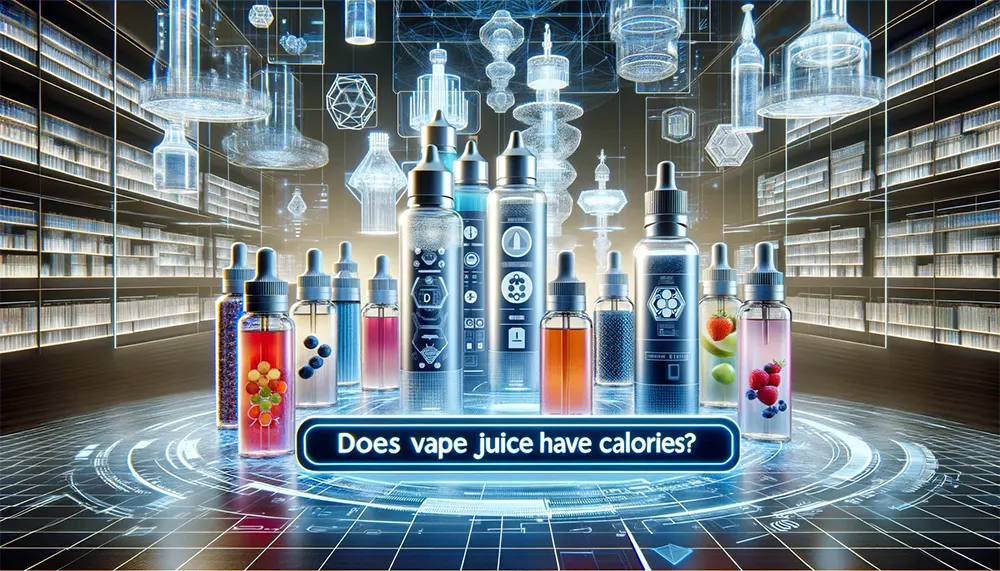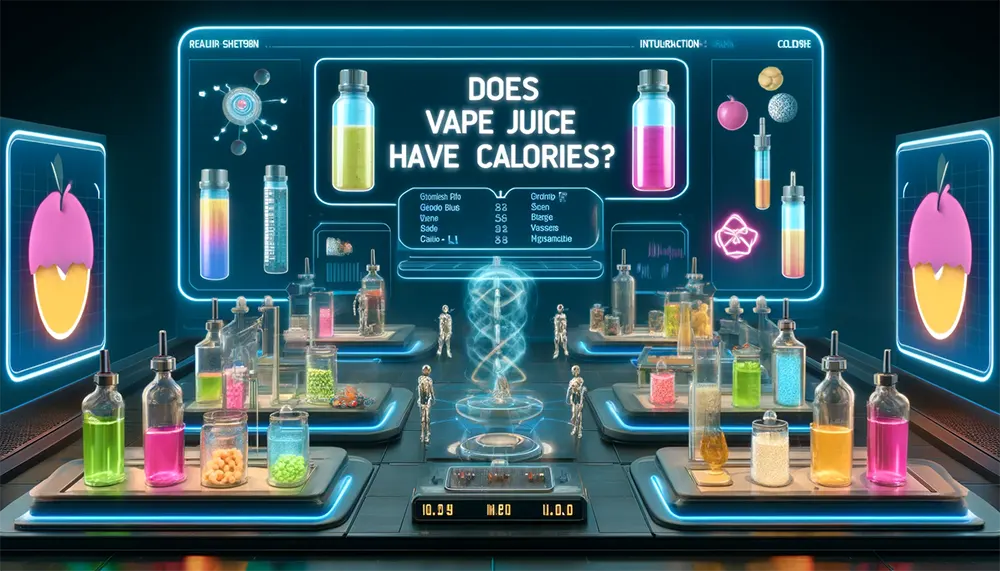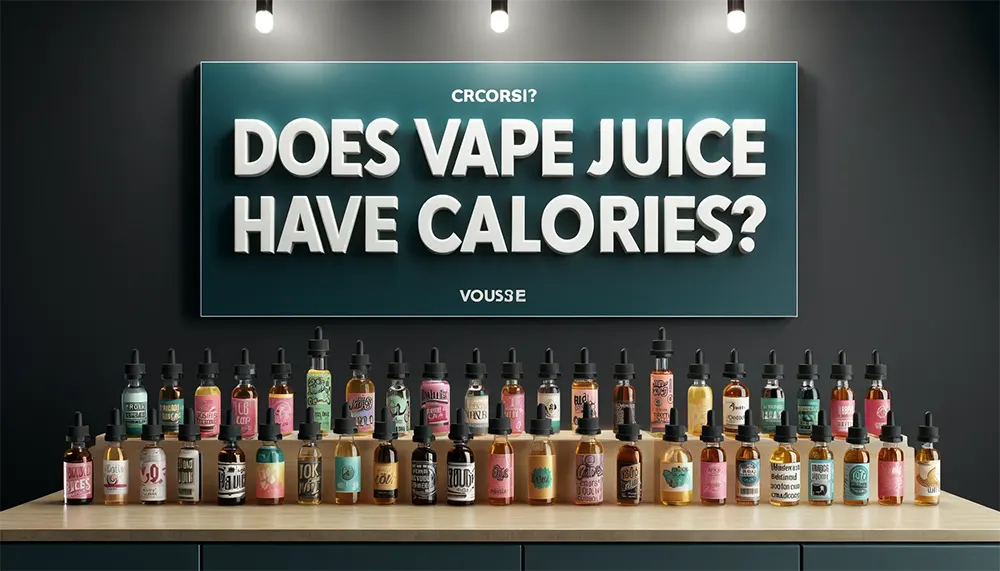Caloric Inquiry: Does Vape Juice Have Calories?
4/9/2024, 5:28:07 PM 1125
Vaping, a practice enjoyed by millions for its range of flavors and the smoking-like experience without the harmful tar and chemicals of traditional cigarette smoke, has generated a myriad of questions about its health implications. “Does vape juice have calories?” This question taps into the broader concerns about weight gain, calorie intake, and overall health that many of us grapple with in today’s wellness-oriented society.
In this comprehensive exploration, we'll address this titular question and provide you with all the information to make informed choices about vaping and its place in your lifestyle.
Does Vape Juice Have Calories?
To thoroughly address whether vape juice contains calories, it's imperative to dissect the components that make up the fluid used in disposable vapes and other electronic cigarettes. The main ingredients typically include vegetable glycerin (VG), propylene glycol (PG), flavorings, and nicotine.
Understanding the Ingredients
VG is a natural substance derived from vegetable oils, known for creating a dense vapor cloud and having a mildly sweet taste. PG, a synthetic substance, is valued for its ability to dissolve flavorings and deliver them effectively when aerosolized. It's thinner than VG and helps to simulate the throat hit that former smokers crave from cigarette smoke.
Caloric Values of VG and PG
VG and PG are categorized as sugar alcohols and do indeed contain calories. Specifically, VG contains about four calories per gram, akin to the caloric density of sugar. PG is slightly less caloric, providing around three calories per gram. While these numbers suggest that vape juice has a significant caloric content, the real impact on your diet is minimal for several reasons.
When vaping, vapers are inhaling the aerosolized form of these liquids, not ingesting them directly. The absorption of calories through the lungs is vastly different from digestive absorption. Most of the exhaled vapor doesn’t contribute to calorie consumption in the same way food does. It means that even if a bottle of e-liquid states a high caloric content per gram, the calories that enter your bloodstream are a fraction of this amount.
The Real Impact on Calorie Intake
Consider a typical usage scenario: a vaper uses about 60ml of e-liquid monthly. Assuming this liquid is a 50/50 mix of VG and PG, the total potential caloric content would be around 540 calories (180 grams at an average of 3.5 calories per gram). However, the fraction of these calories metabolized by the body is actually minimal. Research suggests that only a small percentage of inhaled substances are absorbed through the lungs, and even less so when these substances are not primarily intended for energy use by the body, like VG and PG.
Moreover, these calculations assume continuous, heavy use of a vape device. For casual vapers, the calorie intake from vaping becomes so trivial that it's often considered negligible in the context of an average daily diet of 2000-2500 calories.
Does Nicotine Have Calories?
A common concern among those considering or using nicotine in vape juices and disposable vapes is whether nicotine itself contributes to calorie intake. Given the caloric content discussions surrounding VG and PG, it's also pertinent to examine nicotine.
The Nature of Nicotine
Nicotine is an alkaloid found in the tobacco plant and is the primary psychoactive ingredient in cigarettes, electronic cigarettes, and most vaping products. It's known for its stimulant effects, which can increase heart rate and alertness. But does this highly discussed, often vilified substance also contain calories?
Caloric Content of Nicotine
The answer is straightforward: Nicotine, chemically speaking, does not contain calories. Calories measure energy derived from the macronutrients in our food — namely, fats, proteins, and carbohydrates. Nicotine does not fit into any of these macronutrient categories, which instead is a compound that affects the body’s neurological system.
Nicotine's Impact on Metabolism
Though nicotine itself doesn’t contain calories, it does have an impact on the body’s metabolism. Studies have shown that nicotine can slightly increase the resting metabolic rate, which means that the use of nicotine could cause the body to burn more calories than it would otherwise. This effect, however, is modest and should not be considered a viable method for weight loss.
The metabolic increase is due to nicotine’s stimulant properties. The physiological changes require energy, and thus, the body may burn calories at a slightly higher rate while nicotine is active in the system. However, this should not be misconstrued as an invitation to vape or use nicotine products for weight management or loss. The health risks associated with nicotine consumption far outweigh any potential benefits from minor metabolic increases.
Furthermore, nicotine has been observed in appetite suppression, which could lead to reduced caloric consumption if food intake is lessened. This is one reason why some people may notice weight gain after quitting smoking or abstaining from nicotine usage, as their natural appetite returns.
How Many Calories Are in Flavored Vape Juice or Vape Pens?
Exploring the calorie content of flavored vape juice and vape pens requires a deeper look into how ingredients are formulated and their potential metabolic impact when inhaled. Flavored vape juices add another layer to the consideration of whether these enjoyable puffs could increase your daily calorie intake.
Caloric Content in Flavored Vape Juice
Flavored vape juices typically contain the same base ingredients as unflavored ones — mainly vegetable glycerin (VG) and propylene glycol (PG). As previously discussed, these compounds do have caloric content. However, the additional flavor compounds used to provide the sweet tasting and diverse flavors in vape juice generally do not significantly increase the caloric content. Most artificial and natural flavorings used in e-liquids are calorie-free or contain negligible calories, as they are used in such small amounts.
Calorie Absorption from Vaping
The main question then becomes: how do these trace amounts of calories translate when vaping? The mechanics of vaping involve heating the e-liquid to create an aerosol (often mistakenly called vapor) to inhale. The actual metabolic absorption of calories via inhalation is much less efficient than digestion. Therefore, while the e-liquid might technically contain calories, the amount that potentially be absorbed into your body through vaping is minimal.
Can You Get Calories from Vaping?
As we've established, the primary components of vape juice do contain calories. However, the method of intake must be considered. Vaping involves inhaling vapor, not ingesting e-liquids, and the lungs are not designed to absorb calories or nutrients as efficiently as the digestive system. Therefore, the number of actual calories entering your body through vaping is extremely low. Practically speaking, the caloric content of vaping is negligible concerning daily caloric intake.
Does Vaping Burn Calories?
The act of vaping itself does not burn a significant number of calories. While inhaling and exhaling might seem akin to light physical activities that slightly increase energy expenditure, the calorie burn associated with the physical act of vaping is minimal and not sufficient to have a meaningful impact on calorie balance.
However, nicotine, a common additive in vape juices, has been shown to increase the metabolic rate slightly. Nicotine is a stimulant that can temporarily raise the basal metabolic rate (BMR), which means your body burns more calories at rest. Nonetheless, this effect is too tiny to rely on as a method for significantly counterbalance calorie intake.
Can Vaping Help in Weight Management?
Some anecdotal evidence suggests that nicotine's appetite-suppressant qualities might help some people reduce their caloric intake. Nicotine can curb appetite, which may lead to less eating and, consequently, weight loss if not compensated by other caloric intake. However, using vaping as a weight management tool is not advisable. The health risks associated with nicotine — addiction, heart disease, lung damage, etc. — far outweigh any potential benefits from minor appetite suppression.
Does Vaping Increase Weight?
On the flip side, there is the question of whether vaping can lead to weight gain. This concern is especially relevant for former smokers who have switched to vaping. Quitting smoking often leads to weight gain as normal appetite signals return. Vaping, which is sometimes used as a cessation aid, may stave off this post-smoking weight gain slightly because of nicotine's effects. However, if vaping without nicotine, this would not apply.
Additionally, the sweet-tasting flavors of vape juice might trigger cravings for sugary foods. If a vaper responds to these cravings by consuming more calories, then vaping could indirectly contribute to weight gain.
Throughout this exploration, we've dissected various aspects related to the query, "Does vape juice have calories?" From the caloric content of the base ingredients like VG and propylene glycol to the implications of nicotine on metabolism and weight, we've covered substantial ground to provide a comprehensive understanding for vaping enthusiasts and health-conscious individuals alike.
To recap, the number of calories that may enter the bloodstream from vape juices is minuscule — too little to significantly impact your daily caloric balance.
















